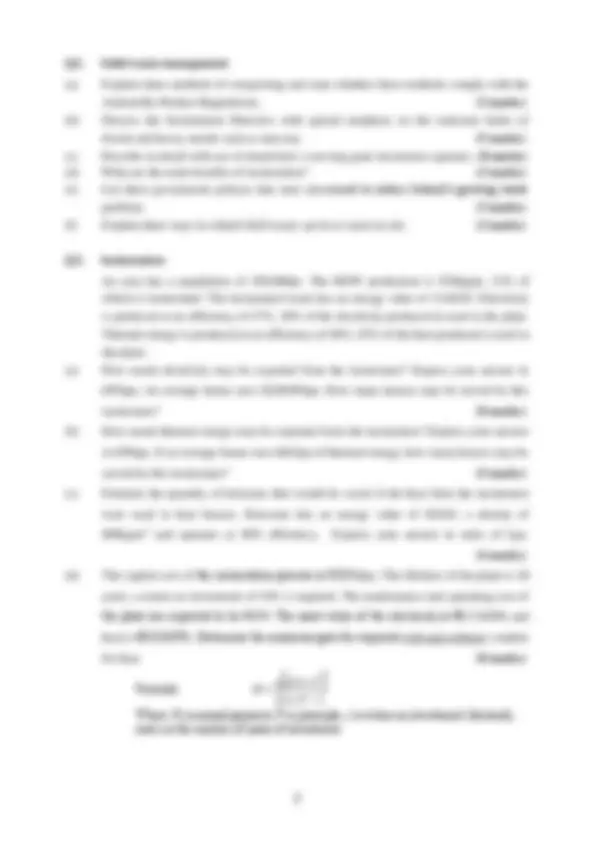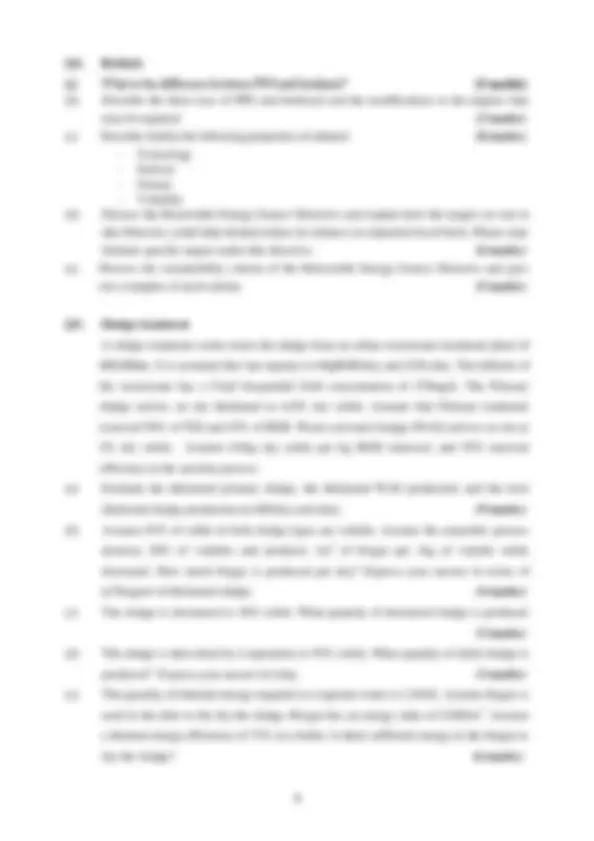




Study with the several resources on Docsity

Earn points by helping other students or get them with a premium plan


Prepare for your exams
Study with the several resources on Docsity

Earn points to download
Earn points by helping other students or get them with a premium plan
Community
Ask the community for help and clear up your study doubts
Discover the best universities in your country according to Docsity users
Free resources
Download our free guides on studying techniques, anxiety management strategies, and thesis advice from Docsity tutors
Information about an environmental and energy engineering examination held at the cork institute of technology in 2011. Details about the modules, programmes, external and internal examiners, instructions, duration, and sitting dates. The examination covers topics such as energy from coal, solid waste management, incineration, and biofuels. Questions in the examination include calculating coal and gas requirements, greenhouse gas savings, composting methods, incineration benefits, and biofuels properties.
Typology: Exams
1 / 4

This page cannot be seen from the preview
Don't miss anything!



Autumn Examinations 2010/
Module Code: CIVL
School: Department of Civil, Structural and Environmental Engineering
Programme Title: Bachelor of Engineering (Hons) in Structural Engineering Certificate in Environmnetal & Energy Engineering Bachelor of Engineering (Hons) in Sustainable Energy Technology
Programme Code: CSTRU_8_Y ESENT_8_Y
External Examiner(s): Dr. M. Richardson Mr. J. O’Mahony
Internal Examiner(s): Dr. N. Power
Instructions: Answer any four question All questions carry equal marks
Duration: 2 Hours
Sitting: August 2011
Requirements for this examination:
Note to Candidates: Please check the Programme Title and the Module Title to ensure that you have received the correct examination paper. If in doubt please contact an Invigilator.
Q1. Energy from Coal A coal burning plant produces 700MWe at maximum efficiency. An efficiency of 36% is obtained. The plant operates on average 85% of the time. It is proposed to convert the plant to natural gas operating with an electrical efficiency of 42%. Again the plant operates on average 85% of the time. (a) Determine the quantity of coal and gas that is required to fuel the power plant (in units of tpa and m^3 pa). (10 marks) (b) Calculate the greenhouse gas savings in units of ktCO 2. (10 marks) (c) Estimate a monetary value of this saving based on a carbon tax of €100/t carbon. (2 marks) (d) A wind turbine operates at maximum efficiency 41% of the time; electricity from wind may be considered CO 2 neutral. What size of wind farm (MWe) is required to affect the same greenhouse gas savings? (3 marks)
Modified Dulong formula Energy content of fuel MJ/t = 337C + 1419 (H 2 – 0.125O 2 ) + 93 S + 23.26N where, C is the percentage of carbon, H 2 is the percentage hydrogen, O 2 is the percentage oxygen, S is the percentage sulphur and N is the percentage nitrogen.
Properties of coal 68 % carbon, 7.2% hydrogen, 4.5% sulphur, 10 % oxygen, 2% nitrogen, 8.3% ash
Properties of natural gas Energy value of natural gas = 43.18MJ/m^3 Density of natural gas (kg/m^3 ): molecular weight divided by 22.412m^3
90 .1% methane (CH 4 ), 6. 3 % Ethane (C 2 H 6 ), 2. 1 % Propane (C 3 H 8 ), 1. 2 % Butane (C 4 H 10 ), 0. 3 % Pentane (C 5 H12) Combustion equations:
1 % methane CH 4 + 2O 2 → CO 2 + 2H 2 O
3 % Ethane C 2 H 6 + 3.5O 2 → 2CO 2 + 3H 2 O 2.1% Propane C 3 H 8 + 5O 2 → 3CO 2 + 4H 2 O
2 % Butane C 4 H 10 + 5.5O 2 → 4CO 2 + 5H 2 O
3 % Pentane C 5 H 12 + 8O 2 → 5CO 2 + 6H 2 O
Combustion equation C + O 2 = CO 2 Molecular weights: C = 12, O = 16 H = 1
Q4. Biofuels (a) What is the difference between PPO and biodiesel? (3 marks) (b) Describe the three uses of PPO and biodiesel and the modifications to the engines that may be required ( 3 marks) (c) Describe briefly the following properties of ethanol: (8 marks)
Q5. Sludge treatment A sludge treatment centre treats the sludge from an urban wastewater treatment plant of 400,000pe. It is assumed that 1pe equates to 60gBOD/day and 225L/day. The influent of the wastewater has a Total Suspended Sold concentration of 270mg/L. The Primary sludge arrives on site thickened to 6.0% dry solids. Assume that Primary treatment removed 50% of TSS and 25% of BOD. Waste activated sludge (WAS) arrives on site at 3% dry solids. Assume 0.6kg dry solids per kg BOD removed, and 95% removal efficiency in the aeration process. (a) Estimate the thickened primary sludge, the thickened WAS production and the total thickened sludge production in tDS/day and t/day. (9 marks) (b) Assume 65% of solids in both sludge types are volatile. Assume the anaerobic process destroys 50% of volatiles and produces 1m^3 of biogas per 1kg of volatile solids destroyed. How much biogas is produced per day? Express your answer in terms of m^3 biogas/t of thickened sludge. (4 marks) (c) The sludge is dewatered to 30% solids. What quantity of dewatered sludge is produced (3 marks) (d) The sludge is then dried by evaporation to 95% solids. What quantity of dried sludge is produced? Express your answer in t/day. (3 marks) (e) The quantity of thermal energy required to evaporate water is 2.5GJ/t. Assume biogas is used in the drier to the dry the sludge. Biogas has an energy value of 21MJ/m^3. Assume a thermal energy efficiency of 75% in a boiler. Is there sufficient energy in the biogas to dry the sludge? (6 marks)